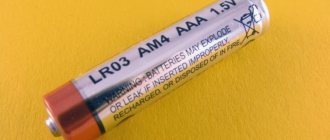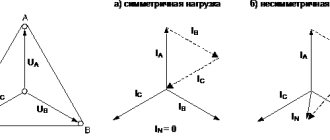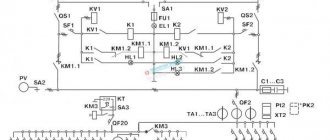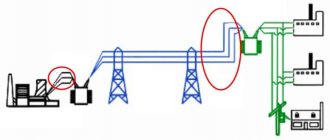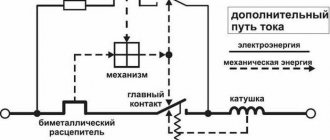Here is a real encyclopedia for both master electricians and beginners, where you will find answers to all the basic questions regarding the electrification of an apartment and a private house: everything about wiring, sockets, light bulbs, tools, devices and protective devices necessary for work. A simple step-by-step guide to drawing up household electrical diagrams and understanding how to calculate power consumption. Specialists with more than 20 years of experience give practical advice that will help you install electrical circuits as accurately, accurately and cost-effectively as possible and help resolve difficulties that arise during the installation and installation of electrical components for your home.
What does electrician study?
Science began to develop rapidly in the 19th century. At that time, the first laws were discovered that made it possible to understand what electricity is. The theoretical foundations were tested in practice. The first electrical devices began to appear, and the means of transmitting electricity from sources to consumers improved.
Electrical science was based on discoveries in the fields of mathematics, physics, and chemistry. She studied the nature, properties of current, electromagnetic fields.
Modern science helps to learn everything about devices that use electricity. Thanks to research, more advanced devices are being created. Electrical engineering is a science that has become the main engine of progress.
Methods for supplying voltage to consumers in an apartment
The electric current from each operating household appliance is summed up in the apartment panel and taken into account by the meter through which the total load passes. Therefore, the current-carrying lines of the apartment panel are made of cables with a thick cross-section, eliminating thermal overload and aging of the insulation.
Wires with a smaller cross-section are laid from the apartment panel to the consumers, since the power of the devices they power is lower. The material and cross-section of the core of these wires are selected from reference books or tables, taking into account operational characteristics and power.
There are three possible ways to implement the scheme:
• a loop (buses), when a common wiring line is created through distribution boxes, and from them there are branches to electrical points (sockets, switches, lamps);
• radial method, which consists in the fact that voltage is supplied to each socket by a separate cable that goes directly from the apartment panel without breaks or connections;
• in a combined way, combining elements of the first two options.
Where to start learning
Electrical manuals “for dummies” are available on information portals. There is no shortage of such materials, so anyone can start studying the discipline from scratch. However, if a person plans to become an electrician, he will have to enroll in the appropriate faculty of a higher or secondary specialized educational institution.
University, technical school, college
Many educational institutions offer professional education as an electrician. It is worth considering the features of training in each of them:
- A full course at a university lasts 4-5 years. A minimum practical basis is given here. However, universities prepare specialists with good theoretical knowledge. Educational institutions accept graduates of 11th grade or secondary educational institutions.
- Technical schools provide an equal amount of theoretical and practical skills. The training is aimed at obtaining a working specialty. Therefore, the theory is studied in less detail than at a university. Technical schools accept graduates of the 9th or 11th grades of school. Training lasts 4 or 3 years, respectively.
- School or college. Such institutions prepare workers, so the theoretical part is kept to a minimum. You can get a profession as an electrician at a school in 1-3 years.
Courses
Such programs help you master basic skills in 2-8 weeks. Lessons are held both in standard and online mode. The disadvantage of the courses is the small amount of knowledge gained. A novice electrician learns the basics of electrical engineering and masters some skills. The student conducts practical classes independently.
All courses are offered on a paid basis, and you can take them without leaving another job.
Self-study
If the described teaching methods are not suitable, a person can master electrical engineering independently with the help of special literature. In this case, the electrician will not be able to perform complex tasks, but he will be able to install the wiring in the apartment. To become an experienced specialist with the help of tutorials, you need to undergo practical training as an electrician's assistant. The student must carefully monitor the actions of the mentor and complete simple tasks.
Introduction
Modern civilization is impossible without electricity. A variety of instruments and devices surround us on all sides. They are pushing cars with internal combustion engines off the roads! Often people don’t even notice the ubiquitous “volt-ampere workers” - until an emergency situation arises: lighting disappears, water does not flow, there is no connection, including cellular, no Internet. And then there is a “catastrophe”. Until the 80s of the last century, the list of electrical household appliances was nowhere shorter - a TV, a vacuum cleaner, an iron, a radio (music center), a refrigerator, a washing machine (not for everyone), light bulbs and, for some, some kitchen appliances. Consequently, the power consumption was quite modest; one or two sockets and one lighting point were enough for one room. In just thirty years, the tandem of engineering and commerce, the engines of scientific and technological progress, has expanded the above modest list almost to infinity. Miniaturization, digital and energy-saving technologies have made it possible to significantly reduce the corresponding avalanche-like growth in energy consumption, however, the requirements for household (apartment and intra-house) electrical networks have increased significantly. The total power, the total number and dispersed location of electricity consumption points require careful and accurate calculation of power supply schemes, as well as the quality of the corresponding communication devices (sockets, switches), protection (safety) and other consumables. The main goal of this book is to help the reader navigate the modern variety of devices, instruments, conductors and circuits. A brief theoretical overview of the basics of electrical engineering will help even a non-professional to correctly calculate the required maximum power for the correct selection of conductors and safety and protection devices. The most common standard electrical connection diagrams will help in drawing up and improving the general electrical diagram of an apartment or private household. An overview of cable and wire products, some new installation products and light bulbs, as well as comparative tables given in the book, will be useful to amateurs and professionals. Practical advice will help you overcome most of the problems that arise during the installation and installation of electrical elements in your home at minimal cost.
Modern trends in the design of a “smart home” raise many questions that have not previously arisen, for example, energy saving, reducing power consumption, choosing a heating method, alternative sources of electricity... A brief overview on this topic, although not in full (after all, more and more perfect devices), will provide answers to some questions and allow you to decide on the choice of one or another solution to the problem.
Electrical connection diagrams
There are 2 main types of circuits in which components are connected in parallel or in series. A novice electrician should study the principles of their construction and operation.
Parallel and serial
In the first case, electricity branches out into all the circuits connected to each other. The total current is equal to the sum of the values in each branch. Circuits connected in parallel receive the same voltage.
When constructing a circuit in series, current flows from one branch to another. A charge of equal strength passes through all circuits.
Installation and operation of electrical wiring (2011)
Author : V.I. Nazarova
The book is needed by those who will be faced with electrical installation work during the construction or redevelopment of a cottage, residential building or summer house. Everything about how to properly install electrical wiring, sockets, switches, panels and lamps. An indispensable book in the work of a professional electrician and home craftsman.
Automatic protection systems
The power grid carries 2 types of threats:
- The power of household wiring is sufficient to ignite materials used in finishing premises. A short circuit in the network leads to an uncontrolled increase in current strength and ignition. It is impossible to reduce the likelihood of such a situation to zero, but it is reduced by introducing a circuit breaker into the circuit. When the current parameters increase, the device plate is deformed, a spring is released, which opens the contacts. The machine does not respond to starting current pulses.
- The neutral wire is connected to the ground, the phase wire is energized in relation to it. A current arises between such a conductor and grounded objects. There is practically no risk of injury to a person by electricity generated between 2 network cables. However, under certain conditions of current flow, electrical injury becomes fatal. Automatic protection systems ensure that current enters one wire and leaves through the other. When voltage appears between the phase and a grounded object, for example, a human body, the RCD de-energizes the network.
Electrical Basics for the Beginner Electrician
In this chapter, we will continue our study of electric current, consider ways to change it, learn more about direct and alternating current, and also consider several new symbols for elements. As mentioned above, the household electrical network is connected to an alternating current source with an oscillation frequency of 50 hertz. This frequency is quite suitable for powering some electrical appliances - such as light bulbs, electric heaters, and AC motors, but the vast majority of electrical consumers require direct current, and at a much lower voltage than that supplied to the mains. How is this problem solved? Now we will consider this issue in the sequence in which this happens in the devices themselves, where the voltage is first reduced to the required level and only then converted to constant.
Transformers - design and principle of operation
There are several ways to reduce voltage, but here we will look at the simplest one - a step-down transformer (a schematic diagram is shown in Figure 13).
Fig. 13 Designation - step-down transformer
Fig. 14 shows the simplest Chinese transformer, it seems to be from a tape recorder, but it clearly shows that a single-phase step-down transformer contains 2 windings, inside of which a metal core is placed. The windings are called primary and secondary. The primary contains a larger number of turns and is connected directly to the electrical network; the secondary contains fewer turns and the reduced voltage is removed from it.
Power transformer
Let's look at how it works. Alternating current (and transformers, chokes and inductors can only be powered with alternating current - they burn out from direct current), passing through the primary winding, generates an electromagnetic field of the same frequency as the supplied voltage. Thanks to the metal core, EMF (electromotive force) occurs in the secondary winding and an output voltage is generated. This voltage can be calculated by knowing the approximate ratio of the number of turns in the windings. So, if the primary winding contains 1000 turns and is powered from a 220 V power supply, and the secondary winding is 100 turns, then the output voltage of the transformer will be about 22 V. The same relationship is also true in the opposite direction, that is, if the number in the secondary is greater , than in the primary, then the transformer will be a step-up one. Now, knowing how to lower the voltage to the required value, let's figure out how to convert it to constant, after all. As already mentioned, most devices are powered by direct current.
Diode and its rectifying properties
In order to more easily understand the principle of current rectification with diodes, let's return to the conversation about alternating current. As explained earlier, mains AC current changes direction 50 times per second. This explanation gives a fairly accurate idea of the essence of alternating current, but does not allow us to understand its structure. The graph in Fig. will help you get a more detailed idea of it. 15, where the waves depicted above zero on the Y scale are a positive half-cycle, and those below 0 are negative.
Fig.15 AC current graph
Thanks to this graph, we understand that the phase wire becomes either a positive or a negative conductor. Seeing this property of alternating current, let's remember the semiconductor diode, which, as is known, passes current only in one direction. By combining these two pieces of knowledge, we understand. that we are already halfway to a solution. And in fact, by passing alternating current through a diode, we get only a positive half-cycle at the output. That is, by connecting two diodes in a circuit in different directions, at the output of the other we will get a negative half-wave, and this is almost a direct current source. But such a current will be pulsating, which is unsuitable for powering equipment (it will work for some time, but very soon it will become unusable). What should I do? But here 2 more diodes (Fig. 16), added to help the first two, will help out. This circuit is called a diode bridge.
Fig. 16 Diode bridge diagram
True, the rectified current will still not be considered completely rectified; its amplitude will be as shown in Figure 17.
Fig.17 Current amplitude
Badly? Fine! There is a way out and we will talk about it now.
Capacitor and its properties
To smooth out the ripple of the current rectified by the diode bridge, we need a capacitor (schematic representation in Figure 18).
Fig. 18 Designation of capacitors on the diagrams
One of its properties is to pass alternating current and retain direct current, which we will use. Due to this property of the capacitor, the residual pulsation passing through it will simply “go into the ground.” In Figure 19 we see how just one capacitor smoothed out the voltage to almost completely constant.
Fig. 19 Diagram showing a capacitor smoothing the voltage
What the circuit of our direct current source will now look like is shown in Figure 20.
Fig.20 DC source circuit
What else do you need to know about the capacitor? Its main property is the possession of electrical capacitance, that is, the ability to accumulate electric current (yes, almost like a battery, only unlike it, a capacitor both charges and releases all the charge almost instantly). This capacity is measured in farads (denoted by the letter F, or Latin F). True, you will most likely never have to deal with such a large capacitance; most often you have to deal with microfarads (1/1000000 fraction of a farad, denoted by the letters mkF), nanofarads (1/1000 microfarad, denoted nF) and picofarads (1/1000 nanofarad , pF).
Fig. 21 Capacitor capacitance units
Capacitors are also divided into dry and electrolytic, the latter have polarity; Figure 18 shows just such a one. Dry ones are indicated in the diagrams in the same way, only without the “+” sign. Now that we know something about coils and a lot about capacitors, it is worth learning and remembering one truth that every electrician needs to know.
Note! The higher the frequency of the current, the higher the inductive reactance and the lower the capacitive reactance.
Translated into normal Russian, this means that in an alternating current circuit the coil has high resistance and the capacitor has low resistance, and with direct current it is the other way around. That is why it was written above that coils cannot be connected to a DC circuit - in the absence of resistance, the current strength increases many times and the coil simply burns out.
Electrical installation work
The creation of electrical networks consists of several stages:
- design;
- preparation of materials and tools;
- wiring gaskets.
Required Tools
To work you will need:
- phase detector;
- pliers;
- wire cutters;
- knives;
- insulating tape;
- screwdrivers;
- multimeter for testing networks.
Removing vinyl insulation from wires (stripping)
The procedure is fraught with some difficulties. It must be carried out in such a way that the current-carrying core is not damaged. Sometimes each conductor is protected with vinyl insulation. A set of such tires is placed in another braid. In this case, you need to cut the top layer without damaging the internal insulation. To remove the braid, use a dull knife; to strip copper or aluminum conductors, use a sharp one.
When cutting insulation, the blade is inserted halfway through the thickness of the material. After this, the wires are pulled apart with pliers. The outer insulation breaks along the cut line.
Insulation
Places of connection or damage to the braid are carefully isolated. During electrical installation, a special tape is used for this. To begin with, the cores are insulated separately, then together. The adhesive applied to the electrical tape should provide a strong hold. The material is securely glued to the vinyl sheathing to a width that prevents peeling or slipping.
Book: Electrician's Tips
Devices for processing products can be divided into two large groups. The first includes devices for processing products, such as electric meat grinders, electric coffee grinders, electric potato peelers, electric juicers, and mixers.
The second group includes cooking appliances, such as electric stoves (electric stove), electric saucepans, electric frying pans, electric ovens, electric coffee makers, electric grills, electric kebabs, electric waffle irons. toasters, microwave ovens.
Food processing devices make work easier in the kitchen, allowing you to do less heavy mechanical work, thereby speeding up the process of preparing food and saving effort.
note
Electric meat grinders, which come in auger and cutter types, are designed for preparing minced meat or fish. Screw electric meat grinders have the same design as a manual meat grinder, with the exception that the rotation of the screw, which feeds parts of the product to the rotating knife, is carried out by an electric motor.
A meat grinder works on the same principle as a coffee grinder: at the bottom of the container in which the product is placed, there is a rotating knife that grinds the product into minced meat.
The design of both types of meat grinder is extremely simple and consists of an electric motor that rotates the auger or cutter knife axially. To protect the motor from overload, meat grinders are equipped with a mechanical protective device.
The cutter meat grinder has a lock that makes it impossible to operate the device without a lid. The design of the meat grinder may include a time relay, a device for storing attachments, and a device for winding a cord.
Attachments and replacement knives must be sold as a set.
Electric coffee grinders are available in two types. Impact coffee grinders are a small cutter that also has a locking mechanism that makes it impossible to operate without a lid. An electric motor drives a two-blade blade located at the bottom of the grinding container.
The design of an impact coffee grinder is even simpler than a cutter grinder. It does not have a time relay, mechanical protective device, or other devices. There is only a button on the case that closes the network.
A burr-type electric coffee grinder grinds coffee beans (as well as other bulk products) using discs, cylinders, cones and other elements that act as millstones.
The most common design of this device has two disk millstones - movable and fixed. The grains are poured into the working mechanism through a special funnel.
The ground product goes into a hopper, from where it can be removed by opening the lid.
This coffee grinder is more convenient, since at the same power as an impact coffee grinder it has a grinding degree regulator that sets the distance between the millstones, it can hold four times more product (125 g versus 30 g in an impact coffee grinder), it also has cord storage device.
The electric potato peeler is designed for preparing potato mass. This operation can be performed using a juicer, but in this case the mass will be heterogeneous.
The potato grater is an electric motor on which a grating disk is attached.
Important
Potatoes are loaded into the hopper, while the grating disc crushes them, and the potato mass, passing through the holes of the cutting elements, comes out into the receiving container.
A juicer designed to extract juice from fruits and vegetables works on the same principle. The juicer also has a grating disc that grinds the product. After this, the crushed mass enters a centrifuge, during which rotation the juice is released. From time to time the centrifuge is cleaned by an ejector.
Potato grinders and juicers have a simple design that allows you to repair them yourself.
As a rule, problems with these devices occur due to the fact that the gap between the grinding disk and the plastic parts of the body increases due to their wear.
In this case, it is recommended to disassemble the device, replace worn parts, and then assemble and adjust the device.
Product processing devices also include a mixer. This device is an electric motor in a plastic case that rotates two axes onto which various attachments are placed. The mixer has step speed adjustment for processing different products.
If the device is made in a desktop version and has a device for squeezing juice from citrus fruits, a tilting mixer operating in a special container, as well as other additional devices, it is usually called a food processor.
Of all the cooking devices, the electric stove is one of the simplest household appliances for processing food. It is a metal stand on which there is a ceramic base with grooves into which the spiral is placed. The tile sometimes has a step heating control.
Advice
However, tiles with an open spiral can be found less and less often, as the open spiral is increasingly being replaced by heating element. This can be explained by the fact that during the cooking process the spiral can be damaged by spilling milk or water on it. Secondly, since the spiral is open, the possibility of an electric shock is likely.
PETN electric stoves are more reliable in this sense. The metal tube protects the heating element from harmful influences and also protects against electrical shock. Otherwise, the electric stove remains the same: it has a step-by-step heating power regulator with the corresponding designations in degrees Celsius.
An electric stove works on the same principle as a heating element electric stove, with the exception that it has an oven. On the front panel there are position switches for heating power, an oven lighting switch, and a thermostat signal lamp.
The heating elements can be folded back to clean the trays; the stove has a lock that prevents the oven and burners from being turned on at the same time. The stove has a lockable lid.
An electric pan is also available with heating element. It has an aluminum or steel body, a thermostat that allows you to regulate the water temperature within 65-95°C, and a thermal switch that turns off the device when the water boils away or is turned on without water.
The device is similar for an electric frying pan. Under the base it has a tubular heater that allows you to heat the work surface to 185°C in 6 minutes.
As in other devices that use heating elements, the frying pan has a thermostat designed to regulate the heating of the working surface in the range from 100 to 275°C.
note
Electric pans are produced for cooking food under high pressure (pressure cookers) and for steaming food (steam cookers).
Electric ovens are designed for baking flour products and for preparing stews from meat, fish and vegetables. The heating element of an electric oven transfers heat evenly across the entire working surface. Some models have a viewing glass on top.
Electrical wire selection
Cables can be single or multi-core. In the first case, there is a single current-carrying wire. In a multicore cable, the bus consists of braided conductors. Wires are also distinguished by the number of conductive elements. To create 3-phase wiring, a 4-core cable is used. Products consisting of 3 conductors are used to create household electrical networks. The wires are made of silver, aluminum or copper.
The first option is used in industrial conditions, due to its high electrical conductivity. In everyday life, copper or aluminum is used.
Kirchhoff's laws
The electrical work of any room is carried out in the form of closed, working electrical circuits. The two main laws that determine processes in electrical networks are Kirchhoff's laws. There are two of them. Both of them apply to both direct and alternating currents.
Kirchhoff's first law states:
The total value of currents directed to an electrical network node is equal to the total value of currents directed from the node.
In practice, the operation of Residual Current Devices (RCDs) is based on Kirchhoff's first law. The operation of the RCD is to turn off the power supply to the network when leakage currents occur. During normal operation, the total value of the current flowing into the electrical network is equal to the value of the current flowing out of it. If the equality of currents is violated, then there is a leak in the network. The RCD is designed and connected in such a way that if there is a current leak, the RCD detects it and disconnects the power supply.
Kirchhoff's second law states:
Any closed loop of an alternating electrical network has equal values of complex voltages and EMF (electromotive forces) on all passive elements of the network.
Note: Complex voltage is the value of AC mains voltage.
Practical application can be explained on any apartment power supply group. For clarification, let's look at an apartment.
No matter how many power supply groups there are in the apartment, at any outlet or lamp the voltage in the network (in operating mode) will be 220 volts.
Electrical engineering and electrical mechanics
These sciences are interrelated. Electrical mechanics studies the basic circuitry of equipment that consumes electricity. The theory and practice course helps you learn how to repair household appliances. The basic principles of electrical mechanics allow you to understand how the engine and generator work, what are the differences between a stabilizer and a transformer.
Electricity - collection of educational books of the USSR
Unified theory of electrical machines. Armensky E.V., Kuzina I.V. - 1975
Designs of electrical machines. Wiedemann, Kellenberger. — 1972
Electrical machines and apparatus. Andrianov V. N. - 1971
Malfunctions of electrical machines. Gemke R. G. - 1989
Electric micromachines. Armensky E.V. - 1975
Dynamos and DC motors. Shenfer K.N. - 1937
Electrical machines: asynchronous machines. Radin, Bruskin, Zorohovich. — 1988
Safety precautions
When working with electrical networks or devices, observe the following rules:
- Before operating or repairing equipment, read the instructions. The safety section specifies unacceptable actions that can lead to short circuits and electric shock.
- The devices must be de-energized. After this, the condition of the wire insulation is assessed. If damage is detected, bare areas are covered with electrical tape.
- If it is impossible to de-energize the electrical network, work in dielectric gloves, shoes with rubber soles and special glasses.
- Access to switchboards and electrical installations is prohibited for novice specialists.
- Do not touch stripped wires with your hands. To find the phase, multimeters, indicator screwdrivers and other tools are used.
Modern Electrician's Handbook (2016)
Author : A.V. Suvorin
The book is intended for engineers and technicians specializing in electrical supply (by industry), for electricians and electricians. The reference book presents a huge theoretical base on the general technical provisions necessary for an electrician. The book contains information on electrical engineering and materials necessary for work, a brief description of lighting equipment, transformers, and DC machines. It also provides information on working with electronic devices and their use. The information in the directory is presented in accessible language.
Recommendations for beginners
A novice electrician should follow these tips:
- When choosing a cable cross-section, a simple law is taken into account: power is equal to voltage multiplied by current. Using this formula, the main current parameters are calculated. Using tables, the cross-section of conductors and the characteristics of other elements of the electrical network are selected.
- The wires are laid strictly horizontally or at right angles. The distance from the ceiling to the cable must be at least 20 cm. If there are pipes in the room, at least 40 cm away from them.
- Distribution boards are installed at a height of 1.2 m. A distance is left between the individual modules to ensure air circulation.
- Electrical circuits are protected by automatic switches that are triggered when current leaks.
To become an experienced electrician, you need to constantly perform practical tasks and improve your skills.
Electrician's Handbook for Pros and more... Modern technologies of the 21st century (2013)
Authors : S.L. Koryakin-Chernyak, M.A. Shustov, O.N. Partala, A.V. Povny, S.B. Shmakov, V.Ya. Volodin, E.A. flour mill
The electrician's directory is needed by those who are looking for all the necessary information in one place. Physical and technical characteristics, conceptual apparatus, names of devices and materials, markings, designations - you will find all this here. The book contains a large amount of electrical information, which is organized into sections and areas of activity of a professional electrician. The reference book is necessary for both a professional and someone who is just learning.
Formulas for direct electric current
A direct electric current does not change in magnitude or direction. It is used to calculate a closed, homogeneous circuit, power and other parameters. Therefore, it is important to know the formulas for it and the basic laws associated with it.
Ohm's law for a section of a homogeneous chain
For electric current to exist, a field is needed. For its formation, potentials or their difference, expressed by voltage, are needed. The current will be directed towards reducing the potentials, and the electrons will begin to move in the opposite direction. In 1826, G. Ohm conducted a study and concluded: the higher the voltage, the greater the current that passes through the section.
For your information! Adjacent conductors conduct electricity differently. That is, each element has its own conductivity, electrical resistance.
As a result, according to Ohm’s theorem, the current strength for a section of a homogeneous circuit will be directly proportional to the voltage across it and inversely proportional to the conductive resistance.
Ohm's law
Using the formula I = U / R, where I is considered to be the current strength, U is the voltage, and R is the electrical resistance, the latter value can be found if p * l / S, where p is the conductor resistivity, l is the length of the conductor, and S — cross-sectional area of the conductor.
Ohm's law for a closed circuit with a current source
Ohm made a formula for a closed circuit. According to it, the current in this section from a current source having internal and external load resistance is equal to dividing the electromotive force of the source by the sum of the internal and external resistance. It looks like this: I = e / R + r, where I is the current force, e is the emf, R is the resistance, and r is the internal resistance of the voltage source.
Note! In the physical sense, according to this law, the higher the EMF, the higher the source of energy, the greater the speed of movement of charges. The higher the resistance, the lower the current.
Ohm's law for a closed circuit
DC operation
Energy, when passed through a conductor, moves in an orderly manner into the carrier. While moving, it does work. As a result, direct current work is the field activity aimed at transferring electrical charges along a conductor. It is equal to I multiplied by the voltage and time performed by the work.
Joule-Lenz law
When electricity passes through any resistive conductor, heat is always released. The amount of heat released over a certain period of time is determined by the Joule-Lenz law. According to the formula, the heat power is equal to the electricity density multiplied by the voltage - w =j * E = oE(2).
Note! In practical terms, the law is important for reducing electricity loss, selecting a conductor for an electrical circuit, selecting an electric heating device and using a fuse to protect the network.
Joule-Lenz law
